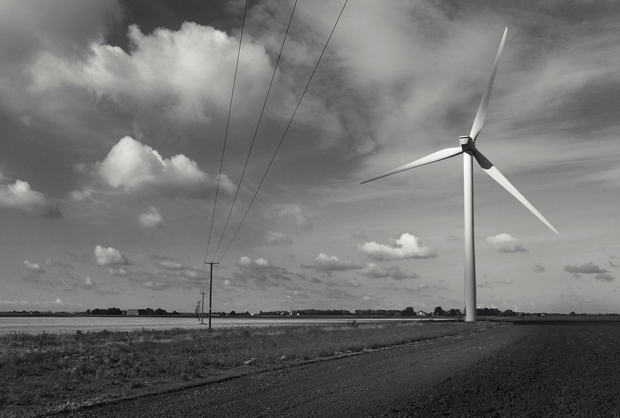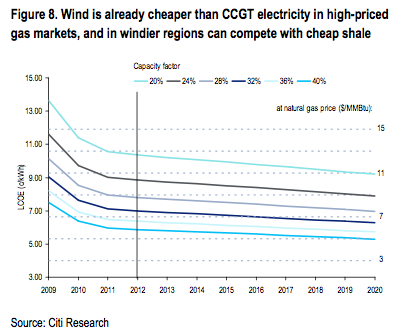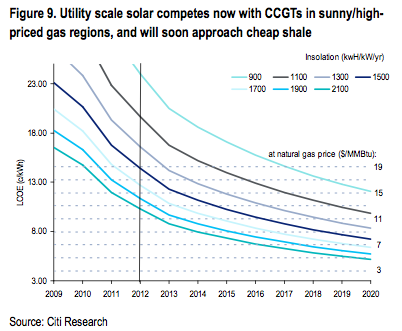The 'unstoppable' renewable grid

The energy transition juggernaut I previewed last May is rolling on unabated, despite U.S. natural gas prices falling to 10-year lows last year. According to a new Gallup poll, two-thirds of Americans would like to see more emphasis on solar, wind and natural gas, while less than half of them support more emphasis on nuclear, oil and coal.
In addition to popular sentiment, installations of renewable generation are proceeding apace. According to the U.S. Federal Energy Regulatory Commission [PDF], the United States installed more power generation capacity from wind than for any other power source in 2012: 10,700 megawatts (MW), 23 percent more than natural gas (8,700 MW) and more than double the new coal capacity (4,500 MW). New solar capacity grew by 1,500 MW, a 31 percent increase over 2011.
It seems that the widespread belief that cheap natural gas would kill the growth of renewables — which I always viewed skeptically and never found convincing data to support — didn’t have much substance after all.
Even in China, the world’s largest consumer of coal, wind generation capacity grew more than coal-fired generation did for the first time ever. Wind power production increased by about 26 terrawatt-hours (TWh) in 2012, while conventional power generation only grew by 12 TWh. More impressively, the Asian giant’s hydropower generation expanded by a whopping 196 TWh, far outpacing all other power generation sources.
U.S. spot prices for natural gas are already back above $4 per million BTU (MMBtu), while gas futures for December 2013 are more than $4.30. My end-of-year target was $4, so gas prices have moved up faster than I expected. As I detailed last year, $4 is really the minimum profitable price for low-cost shale gas producers, so gas production might finally start growing again after a full year of stagnation. According to the U.S. Energy Information Administration (EIA), gas production in January 2013 (the most recent month for which data is available) was 2.127 trillion cubic feet (tcf), which is still below the year-earlier level of 2.149 tcf. However, minimal profitability isn’t enough to attract a fresh round of development capital, and I would not expect a significant growth spurt until gas gets back to $5 or more. The future of shale gas is still murky.
The price of natural gas is emerging as a key factor in the deployment of renewable power.
As I’ve detailed in previous columns, renewables have begun pushing nuclear and coal off the grid in regions where renewables provide a significant fraction of grid power. This is primarily because their priority dispatch on the grid and their generation at times of peak demand are destroying the economics of traditional “baseload” generation. But gas is a natural complement to the variable output of wind and solar, because gas-fired “peaking” plants are able to ramp up and down quickly to fill in when renewable generation fluctuates.
In order to have a grid mostly powered by renewables, it will be important for gas prices to remain competitive with coal and nuclear. At the same time, the cost of unsubsidized renewable power must continue to fall until it is competitive with fossil fuels. Several new reports find that it will reach that point in key areas by 2020.
Citigroup study
A new report by Citigroup, nicely summarized by Giles Parkinson for Renew Economy, forecasts that solar will be competitive with fossil-fueled grid power in much of the world by the end of the decade, and that “the perception of renewables as an expensive source of electricity is largely obsolete.”
The report offered two charts showing the natural gas prices at which wind and utility-scale solar are competitive with gas-fired power generation.

The wind chart plots “capacity factors” against gas prices. A capacity factor indicates the actual output of a wind farm, expressed as a percentage of the output it would have if it were running full time at full “nameplate” capacity. So, a 1 MW wind farm with a 32 percent capacity factor would produce 2,803 MWh of power per year (1 MW x 8760 hours in a year x 0.32).
EIA offers an average capacity factor for U.S. wind of 33 percent, while recent (2010-2012) estimates compiled by the National Renewable Energy Laboratory (NREL) give a median capacity factor of 38 percent for onshore wind and 39 percent for offshore wind.
In the Citi chart, wind at a 32 percent capacity factor was competitive with natural gas at about $7.50/MMBtu in 2012, and will be competitive with gas at about $6.50 by 2020. In very windy locations with capacity factors of 40 percent, wind is already competitive with gas priced below $6, and would be competitive with gas at $5 by 2020.
Put another way, both onshore and offshore wind would be cheaper than gas-fired power in the United States at a gas price of $6/MMBtu or more. Natural gas at $6 would make most of the U.S. shale gas industry profitable, and seems like a good bet for 2020, if not sooner.

For utility-scale solar, Citi cites various solar insolation factors (kWh/kW/year). Insolation factors reflect how sunny a given region is. An insolation factor of 2100 would correspond to a capacity factor of 24 percent (2100 ÷ 8,760 hours in a year). For U.S. solar PV, EIA (which skews a bit to the high side) gives an average capacity factor of 25 percent, while recent estimates compiled by NREL range from 20 to 28 percent.
The Citi chart shows that utility-scale solar in very sunny regions (with an insolation factor of 2100) is already competitive with gas-fired power at a gas price of about $12.50/MMBtu, and by 2020, will be cheaper than gas-fired power at a gas price of $5.
The upshot of the Citi report? By 2020, if gas prices are at $6/MMBtu or higher, both utility-scale solar and wind will be cheaper than gas-fired power in the United States. The analysts also note that “utility-scale solar is rapidly approaching parity with wholesale electricity prices in a number of countries, including Italy, Spain, the US and China.”
“Unstoppable”
A number of additional studies likewise point to renewables reaching grid parity by the end of this decade.
Researchers at Stanford University project that utility-scale solar will reach grid parity by 2020, and “commercial-scale” installations could reach that point about two years later without federal tax incentives.
The Institute for Local Self-Reliance finds that rooftop PV is already cheaper than grid power for more than 10 percent of residential demand in five U.S. states. By 2022, the same will be true for every state except Washington, where there isn’t much sun and hydropower is simply too cheap.
Parkinson has helpfully rounded up several more recent reports from global investment banks that have suddenly turned extremely bullish on renewables.
Global investment bank UBS believes that unsubsidized rooftop solar is becoming an economic “no brainer” in much of Europe, and that “every family home and every commercial rooftop in Germany, Italy and Spain should be equipped with a solar system by the end of this decade.” Macquarie Group says “solar installations could continue at a rapid pace even without subsidies” in Germany, where the price of rooftop solar has nearly reached grid parity, making it “unstoppable.” And Deutsche Bank notes that unsubsidized solar is already at grid parity in India and Italy, while demand for solar projects in the United States and China is strong even where subsidies are low. By next year, Deutsche sees solar “transitioning from subsidised to sustainable markets” in much of the world.
Another new study found that if solar PV were installed on every suitable rooftop in Australia, it would more than meet all of the residential energy demand for the country and drive down the price of grid power from an average of $0.30/kWh to $0.07/kWh, making it another economic no-brainer in a country that’s rich in coal.
Building fully renewable grids
Meanwhile, evidence continues to mount that the grid can accommodate much higher levels of renewable power than previously assumed, without significant amounts of storage or major grid reconfiguration. (New readers might want to explore my previous columns on this topic: “Designing the grid for renewables” and “Coming soon: 100% renewable power.”)
Craig Morris, an astute English-language observer on Germany’s energy transition, recently highlighted a study by a German engineering association that found the grid could handle up 40 percent of its power from variable renewables without any real investment in storage. Renewables already provide about 25 percent of the grid’s total power. Accommodating an 80 percent share from renewables, which is Germany’s target for 2050, would only require about 14 GW of short-term and 18 GW of seasonal power storage, and raise the price of grid power about 10 percent over 2010 levels (from 78 €/MWh to 84 €/MWh). At that point, nuclear power will be completely phased out, and coal-fired power will all but disappear.
If gas prices rise to around $6 in the United States by 2020, and stay in the $6-$12 range, then gas-fired peaking plants should be the most economical way to meet the last 20 percent or so of grid power for most of the world’s grids, at least until scalable and affordable storage options arrive.
On that note, I am looking forward to covering the first Pathways to 100% Renewable Energy conference in San Francisco two weeks from now. The speaker lineup is excellent, and includes several thought-leaders whose work I have followed for years, including Lancaster, Calif., mayor Rex Parris, who I profiled last June. (Under Parris’ leadership, Lancaster recently became the first city in the nation to require that all new residential developments come equipped with at least 1 kW of solar PV per home.)
It should be a fascinating opportunity to see how renewably powered grids are taking shape in the United States and elsewhere. If you are planning to be there, please say hello.
You can return to the main Market News page, or press the Back button on your browser.

